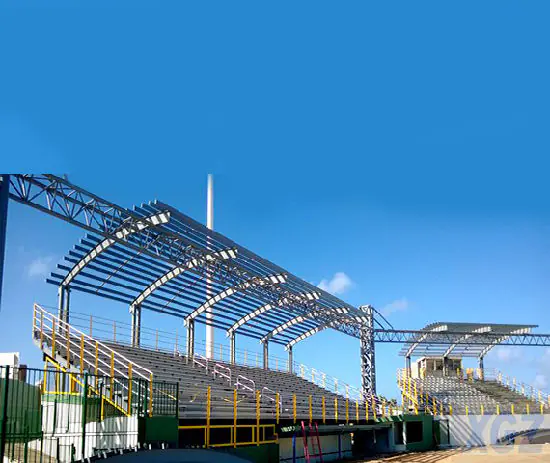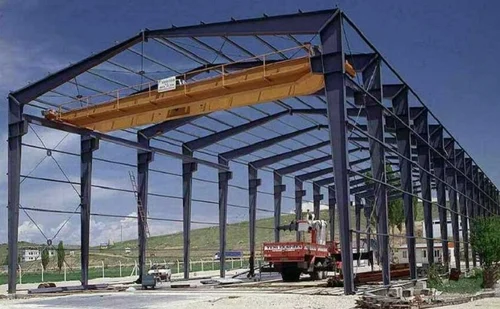Steel Frame Structures: Advantages and Applications in Modern Construction
In the realm of modern construction, steel frame structures have emerged as a cornerstone due to their robustness, versatility, and sustainability. This article delves into the intricacies of steel frame structures, their benefits, and their diverse applications across construction projects.
Understanding Steel Frame Structures
A steel frame structure refers to a skeletal framework composed of steel columns, beams, and connections in steel structure system. This structural system is engineered to support building loads and ensure stability over large spans. Steel frame structures are renowned for their strength-to-weight ratio, making them ideal for high-rise buildings, industrial facilities, and various architectural applications.

Understanding Steel Frame Structures
Advantages of Steel Frame Structures
- Exceptional Strength and Durability Steel frame structures are renowned for their exceptional strength, capable of withstanding high winds, seismic forces, and heavy loads without compromising structural integrity. Steel’s inherent properties make it resistant to warping, cracking, and corrosion, ensuring longevity and minimal maintenance requirements.
- Design Flexibility Steel’s malleability allows architects and engineers to create complex and innovative designs. Steel frame structures can be customized to accommodate specific architectural aesthetics and functional requirements, offering unparalleled design flexibility compared to traditional construction materials.
- Speed of Construction Prefabricated steel components facilitate faster construction timelines compared to conventional methods. The precision manufacturing of steel frames reduces on-site assembly time and labor costs, accelerating project completion while maintaining quality standards.
- Sustainability Steel is a highly sustainable building material due to its recyclability and minimal environmental impact. Using steel frame structures promotes eco-friendly construction practices by reducing waste generation and energy consumption throughout the building’s lifecycle.
- Fire Resistance Steel frame structures offer superior fire resistance compared to wood or concrete counterparts. Steel does not contribute to the spread of flames and can withstand high temperatures for prolonged periods, enhancing building safety and compliance with fire regulations.

Advantages of Steel Frame Structures
Applications of Steel Frame Structures in Modern Construction
- Commercial Buildings Skyscrapers, office complexes, and retail centers utilize steel frame structures for their ability to support large floor areas and withstand urban environments’ demands. The flexibility of this steel structure system allows for open floor plans and adaptable interior spaces that cater to diverse tenant needs.
- Industrial Facilities Warehouses, manufacturing plants, and logistics hubs benefit from steel frame structures’ durability and expansive interior capacities. Steel’s load-bearing capabilities and resistance to environmental stressors make it suitable for housing heavy machinery and goods storage.
- Residential Construction High-end residences and apartment buildings increasingly incorporate steel frame structures for their reliability and design versatility. Steel allows for spacious living areas, expansive windows, and innovative architectural designs that enhance residential appeal and functionality.
- Infrastructure Projects Bridges, stadiums, and transportation terminals utilize steel frame structures to span vast distances and accommodate heavy foot traffic or vehicular loads. Steel’s adaptability to dynamic structural demands ensures the longevity and safety of critical infrastructure assets.
Tips for Choosing Steel Frame Structures
- Engineering Consultation Collaborate with experienced structural engineers to design steel frame structures that meet project specifications and regulatory requirements. Professional guidance ensures structural integrity and compliance with local building codes.
- Material Selection Specify high-quality steel grades and finishes that enhance structural performance and durability. Consider environmental factors and lifecycle costs to maximize the long-term value of steel frame investments.
- Construction Management Implement rigorous quality control measures during steel frame installation to minimize errors and optimize construction timelines. Regular inspections and maintenance routines prolong the operational lifespan of steel frame structures.

Tips for Choosing Steel Frame Structures
Steel frame structures epitomize the evolution of modern construction practices, offering unparalleled strength, design flexibility, and sustainability across diverse building applications. Whether employed in commercial skyscrapers, industrial facilities, residential developments, or critical infrastructure projects, steel frame structures embody resilience and innovation in the built environment. As technological advancements continue to enhance steel manufacturing and engineering capabilities, the versatility and benefits of steel frame structures are poised to shape the future of global construction endeavors.


Post Comment